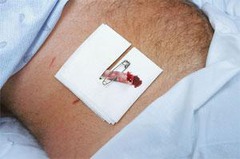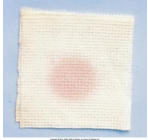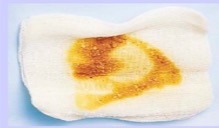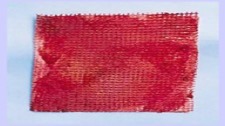Module 18:Wound Care- Lesson 2: Wound drainage system – Flashcards
Unlock all answers in this set
Unlock answersquestion
delayed
answer
If drainage accumulates in the wound bed, wound healing is
question
skin surface

answer
An open drain system (e.g., a Penrose drain) removes drainage from the wound and deposits it onto the
question
closed drain system
answer
A _____ drain system, such as the Jackson-Pratt (JP) drain or Hemovac drain, relies upon the presence of a vacuum to withdraw accumulated drainage from around the wound bed into the collection device.
question
Examples of a closed drain system are
answer
Jackson-Pratt drain or Hemovac drain
question
JP drain collects fluid that is in the range
answer
100 to 200 mL/24 hr
question
Hemovac drain collects fluid that is in the range
answer
usually up to 500 mL/24 hr.
question
The assessment of wound drainage and maintenance of drains and the drainage system (can/cannot) be delegated to a NAP
answer
cannot
question
What can the nurse delegate to NAP a.emptying a closed drainage container or pouch, b.measuring the amount of drainage, c.reporting the amount on the patient's intake and output (I&O) record d. Instructing to report to the nurse any change in amount, color, or odor of drainage e. all of the above
answer
E. all of the above
question
A patient is returning from surgery with an abdominal incision. Because a large amount of drainage is anticipated, which type of drainage system would you expect for the patient to have? a. Jackson-Pratt drain b. Hemovac drainage system c. Wound V.A.C. d. Penrose drain
answer
B. hemovac drainage system; A Hemovac drainage system can be used for larger amounts (up to 500 mL) of drainage
question
The nursing assistant measures the contents from a wound drain. Why should the NAP do this? a. To determine if the amount of drainage is decreasing with time b. To record the patient's input c. To record the patient's output d. To determine adequate blood replacement e. It is inappropriate to delegate emptying of a drain to NAP.
answer
C. to record the patient's output
question
Types of Wound Drainage: Serous

answer
clear, watery plasma
question
Types of wound drainage: purulent

answer
thick, yellow, pale green, or white: indicates infection
question
Types of wound drainage: serosanguineous

answer
Pale, red, watery: mixture of serous and sanguineous
question
Types of wound drainage: sanguineous

answer
bright red: indicates active bleeding
question
wound culture
answer
may be ordered to identify bacteria growing within a wound
question
The nurse assesses the number of drains, drain placement, character of drainage (amount and type), and condition of collecting apparatus (fullness and function of suction). This assessment includes the following
answer
-Identify presence, location, and purpose of closed wound drain or drainage system -Identify number of drain tubes and what each one will be draining -assess if drain tube needs self-suction, wall suction, or no suction by checking the HCP's orders -inspect system to determine presence of one straight tube or Y-tube arrangement with two tube insertion sites -inspect system to ensure proper functioning
question
equipment necessary to empty a wound drainage system
answer
graduated measuring cylinder alcohol sponge gauze sponges sterile specimen container, if culture is needed sterile dressings clean gloves disposable drape goggles, if splash risk is present safety pin(s)
question
What are the expected outcomes after emptying a wound drainage system A. wound healing continues B. Vacuum is re-established C. tubing is patent D. all of the above
answer
D. all of the above
question
Which of the following indicates an expected outcome related to wound drainage systems? a. Drain tube is loose and able to move within wound bed. b. There is an absence of drainage in the Jackson-Pratt drain reservoir and the incision appears slightly swollen. c. The patient is complaining of pain, and the drainage appears thick and cloudy. d. The Penrose drain is located next to incision and has a safety pin in the drainage tube.
answer
d. The Penrose drain is located next to incision and has a safety pin in the drainage tube. An expected outcome is that the drainage device is properly located and intact. A safety pin prevents the tubing from migrating into the wound.
question
The patient is watching the nurse empty his Hemovac. The patient asks why the nurse compresses the Hemovac after emptying it. The nurse's best response is: a. "To make sure that all of the drainage is out of it" b. "The drain is compressed to reestablish vacuum." c. "To make the drain reservoir smaller" d. "Why are you worrying about your drain?"
answer
b. "The drain is compressed to reestablish vacuum." Compressing the drain reservoir reestablishes the vacuum, enabling the drain to exert negative pressure and draw fluid from the wound bed.
question
Where should the nurse discard the drainage once it is emptied from the drain reservoir? a. In the sink b. In a specimen container placed in a biohazard bag c. In the commode d. After measuring the drainage, gently reinsert into the patient to maintain blood volume.
answer
c. In the commode The drainage should be flushed down the commode.
question
Evaluation includes
answer
-observe for drainage in suction device -inspect wound for draiange or collection of drainage fluid under the skin, causing a seroma -measure drainage, empty drainage system, record on I&O form -assess patient's level of comfort using the 0-10 scale
question
When should the drainage evacuator be emptied? (select all that apply) a. every 8 to 12 hours b.every 24 hours c.when it becomes one-half to two-thirds full d.when it becomes full
answer
A and C Keeping the drainage empty promotes optimal functioning by maintaining the vacuum and eliminates a source of bacterial growth
question
which of the following should the nurse examine when evaluating the effectiveness of drain function? (select all that apply) A. amount of drainage B. color of drainage C. distance of drain from incision site D. conditions of wound
answer
A, B, C The nurse should evaluate the color and amount of drainage, and conditions of the wound
question
Unexpected outcomes: site where tube exits becomes infected
answer
Intervention: -notify health care provider -use aseptic technique when changing dressing
question
Unexpected outcomes: bleeding appears around drainage collector
answer
intervention: - determine amount of bleeding and notify HCP if excessive -assess for tension on patient's drainage tube -secure tubing to prevent pulling
question
Unexpected outcome: drainage suction device is not accumulating drainage
answer
Intervention: -assess drainage tubing for clots -assess drainage system for air leaks or kinks -notify HCP
question
Unexpected outcome: patient experiences pain
answer
-assess pain level and provide medication -stabilize drainage tubing to reduce tension and pulling against incision
question
Roy Banks had surgery for repair of an abdominal aneurysm. He has a 10 cm (4 inches) abdominal incision and a Jackson-Pratt drain. What preventive measure can you instruct the patient to take to prevent dehiscence? a. Avoid coughing and position change. b. Notify you if his pain worsens. c. Perform hand hygiene frequently. d. Splint his abdomen with a folded towel or pillow when coughing or changing position.
answer
d. Splint his abdomen with a folded towel or pillow when coughing or changing position. You should instruct the patient to splint his abdomen when moving or coughing to provide support to the tissues.
question
Two hours after Roy's surgery, you empty the Jackson-Pratt evacuator of 20 mL serous drainage. What action should you take next? a. Notify the health care provider and maintain patient on NPO status. b. Document the amount on the patient's output record. c. Increase the IV by 20 mL to replace the fluid loss. d. Nothing, because this is a normal finding.
answer
b. Document the amount on the patient's output record. You should document the amount on the patient's output record and continue to monitor.
question
What should you be observing when evaluating ROy and his drain to determine that the drain is functioning as expected? a. roy's level of comfort b. the type and amount of drainage in the evacuator c. vital signs and insertion site d. capillary refill of toes e. if the evacuator is compressed
answer
A, b, c, e,



